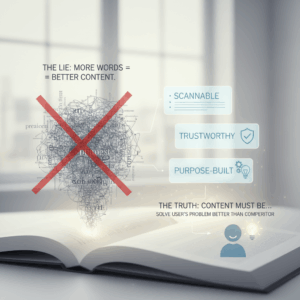The Content Crisis – You Wrote a Brochure, Not a Solution. This is the second in a series on why affiliate marketing is impossible unless?
Blog by Peter Hanley coachhanley.com
The Lie: More words equal better content. The Truth: Content must be Scannable, Trustworthy, and Purpose-Built to solve the user’s problem better than the competitor.
You survived the Keyword Authority hurdle (Part 1). You’re getting impressions, maybe even a few clicks. But those users immediately bounce, leaving your conversion rate stuck at 0.1%. Why?
Because you fell into the TFC Trap: Thin, Feature-Centric Content.
The TFC Trap: Where Momentum Dies
Most beginner affiliate content (and the content from the 80% who give up) is nothing more than a rewritten brochure. It describes what the product is (its features) instead of what the product does (the user’s transformation).
When a high-intent user lands on your page, they are asking two questions:
- Do you understand my unique, urgent problem? (Trust)
- Can you get me to the solution faster? (Scannability/Click)
If your content fails to nail both, they click back to Google. This is the Content Crisis—when your hard-earned traffic hits a dead end.
Failure Point 2: Static, Unscannable Walls of Text
In the high-stakes environment of transactional searches, users are not reading; they are scanning for confidence signals.
- The 80% Mistake: Using long, dense paragraphs, burying the conclusion, and failing to use visual aids like tables or boxes. They make the content hard to consume.
- The Architect’s Fix:Aggressive Scannability. Implement:
- Comparison Tables: High-contrast, immediately visible, answering the “which one is best” question instantly.
- In-Content CTAs: Strategic, benefit-driven callouts placed immediately after the core problem is acknowledged.
- Short Sentences/Short Paragraphs: Guaranteeing fast consumption, especially on mobile devices.
You must accept that high-intent users are impatient. Your content’s job is to respect their time and guide them immediately to the solution (the click).
The Content Mandate: Transformation, Not Description
Your content is the bridge of trust. If that bridge is rickety (thin) and confusing (unscannable), no one crosses.
| Failure Action (The 80%) | Success Action (The Architect) |
|---|---|
| Listing features of Product A and Product B. | Describing the transformation (e.g., “Stop wasting 30 minutes chopping, and start drinking your smoothie in 5.”) |
| Burying the link in the last paragraph of the review. | Using 3-4 diverse, benefit-driven CTAs strategically placed at points of peak reading intent. |
| Writing from a desk without unique opinions or experiences. | Injecting Unique Value—actual hands-on data, custom pros/cons, and personal conviction. |
The Fix: Creating Conversion-Focused Content
Your content must be designed to generate the click. It must prioritize user experience and confidence above all else.
- Reverse Engineer the SERP: Find the page ranking #1 and identify its weakest point. Then, create content that fixes that weakness (e.g., their comparison table is messy; yours is clean and interactive).
- Focus on the First 30 Seconds: Can a mobile user, scanning your page for 30 seconds, confidently identify the best product and the best next step? If not, optimize for speed and scannability.
The Content Crisis is a crisis of value. The 80% fail because their content provides minimal value, forcing the user to return to Google for a better answer. You must be the final answer.
Blog Template, images and logos by Wealthy Affiliate reserch and writing support by Gemini

